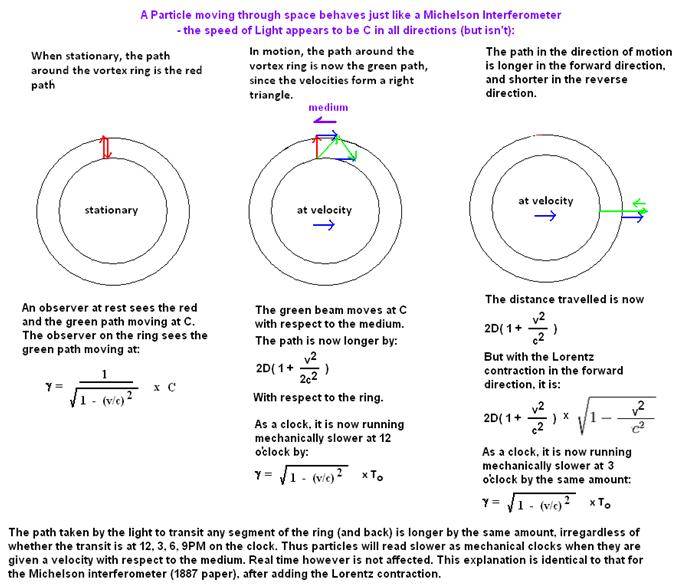The
mechanism of Time Dilation, and how it could be an illusion: If one considers the classic
thought experiment of time dilation,
in which a light beam bounces between two mirrors travelling at
relativistic speeds, it becomes clear that the time measured by a
stationary observer vs. that of a moving observer is different if we
rely on the time taken to move from one mirror to the other as the
clock for both. From the perspective of the moving observer, the path
is much longer, so it takes more time to reach the mirror. Thus time mathematically is
directly inter-convertible with the velocity of light –if the velocity
of the moving observer adds or subtracts from the speed of light,
rather than being the same for both observers, then time
dilation is reduced to a mechanical effect on clocks.
Particles
have a wave nature, akin to that of light. These periodic vibrations
pass to and fro across the body of the particle or around the
periphery, at a velocity directly linked to the speed of light. Imagine
a particle to be like a clock, in the shape of a disk, with a light
path across the surface of the ring,
the light
reflecting back and forth around the disk progressively through from 12
o’clock to 12 o’clock. This particle as a clock can be understood in
exactly the same way as the Michelson
Interferometer,
and the explanation for the interferometer light speeds in the vertical
and horizontal arms correspond to the transit of light across the
segments of the disk shown in figure 3 below. Michelson showed that if space contained a medium moving relative to the Earth, then the interferometer would experience a lengthening of the vertical (12 o’clock) path by 2D(1+ v2/2c2), and a lengthening of the 3 o’clock path by 2D(1+ v2/c2). The 3 o’clock path would be longer by 2x the factor of the 12 o’clock path. However, since the clock in the path parallel to the velocity is altered by the Lorentz contraction by (1 - v2/c2)1/2, this path difference exactly cancels. Thus the measured speed of light appears to be the same for both the moving interferometer and the moving particle disk. However, the real path for light is longer by 1/(1 - v2/c2)1/2 all around the ring, and thus as a mechanical clock based on the speed of light, it will always run slower as it velocity increases with respect to any other inertial rest frame. However, absolute time does not actually change. Fig. 3 The Particle as a Clock:
This idea is consistent with the result of the Ives and Stillwell Experiment (1938, 1941). The moving atomic clock (protons) in the experiment emit a light ray which is frequency shifted by (1-v2/c2)1/2. So
if the Michelson interferometer is considered a light clock
moving through space at some velocity v, then its time counting will
slow with its velocity by (1-v2/c2)1/2.
just like that predicted by Einstein, except it can be explained by a
different reason - because the speed of light could be constant in some
static frame of reference and because Lorentz's assumption that the
physical Lorentz contraction is valid. This would mean that
the
passage of time can actually be absolute regardless of velocity, but
that clocks based on the speed of light measured with respect to a
preferred frame of reference will always read in error.
The perfection by which this process erases any detectability of our motion through space is truly astounding. If we consider the effect on the laser driving the Michelson interferometer, its constituents are also equally affected in the same way, lowering the frequency of the laser beam by the exact same amount. This means that not only is there no fringe shirt in the interferometer when it is moving, but an observer moving with it will always measure the propagation time along any arm to be exactly C . This is shown in our simulation of a Michelson interferometer here. Even the angles at which the light passes from one mirror to another is perfectly corrected during motion so that any observer moving with the device would only see the light paths moving rectilinearly, regarless of how fast they are moving. This was discussed in detail by Herbert Ives in his 1937 paper where he noted: “The
Fitzgerald-Lorentz contraction may be considered a means
of introducing a tilt of the inclined mirror just sufficient to correct
this error
and bring the two emergent pulses into coincidence.”
This phenomena is discussed at greater length in a research article here. So we faced then with the possibilty that the speed of light is not actually constant for all inertial observers, and that real time does not actually slow down with velocity. Rather, this could simply be an illusion caused by our clocks being calibrated so to speak by the velocity of light with respect to absolute space. This is kind of like saying that we have a theromometer that is biased by changes in heat. It reads wrong due to the very thing we want to measure. So no matter what temperature it is, it alsways reads the same thing!  References:
1) Ives, Herbert, “The
Doppler Effect Considered in Relation to the Michelson-Morley Experiment.”
J.O.S.A. Vol.27, 1937, p.389. 2) Ives, Herbert, “ An
Experimental Study of the Rate of a Moving Atomic Clock.” J.O.S.A. Vol. 28, 1938, P.
215. 3) Ives, Herbert, “ An Experimental Study of the Rate of a Moving Atomic Clock.” II J.O.S.A. Vol. 31, 1941, P. 369. |

















